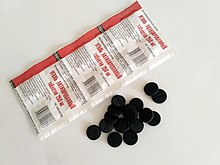
Back فحم منشط (دواء) Arabic Golosg actifedig Welsh Carbón activado (toxicología) Spanish زغال فعال (دارو) Persian Charbon de Belloc French פחם פעיל (תרופה) HE सक्रिय चारकोल (दवा) Hindi Ակտիվացած փայտածուխ Armenian ଆକ୍ଟିଭେଟେଡ ଚାରକୋଲ OR Aktiverat kol (läkemedel) Swedish
 Activated charcoal for medical use | |
| Clinical data | |
|---|---|
| Trade names | CharcoAid, others |
| AHFS/Drugs.com | Monograph |
| Routes of administration | by mouth, nasogastric tube |
| Identifiers | |
| CAS Number | |
| ChemSpider |
|
| UNII | |
| CompTox Dashboard (EPA) | |
| ECHA InfoCard | 100.036.697 |
Activated charcoal, also known as activated carbon, is a medication used to treat poisonings that occurred by mouth.[1] To be effective it must be used within a short time of the poisoning occurring, typically an hour.[1][2] It does not work for poisonings by cyanide, corrosive agents, iron, lithium, alcohols, or malathion.[2] It may be taken by mouth or given by a nasogastric tube.[3] Other uses include inside hemoperfusion machines.[1]
Common side effects include vomiting, black stools, diarrhea, and constipation.[1] A more serious side effect, pneumonitis, may result if aspirated into the lungs.[1][2] Gastrointestinal obstruction and ileus are less common but serious adverse effects.[1] Use in pregnancy and breastfeeding is generally safe.[3] Activated charcoal works by adsorbing the toxin.[1]
While charcoal has been used since ancient times for poisonings, activated charcoal has been used since the 1900s.[4][5] It is on the World Health Organization's List of Essential Medicines.[6]
- ^ a b c d e f g "Charcoal, Activated". The American Society of Health-System Pharmacists. Archived from the original on 21 December 2016. Retrieved 8 December 2016.
- ^ a b c World Health Organization (2009). Stuart MC, Kouimtzi M, Hill SR (eds.). WHO Model Formulary 2008. World Health Organization. p. 57. hdl:10665/44053. ISBN 9789241547659.
- ^ a b Hamilton R (2015). Tarascon Pocket Pharmacopoeia 2015 Deluxe Lab-Coat Edition. Jones & Bartlett Learning. p. 469. ISBN 9781284057560.
- ^ Cecen F, Aktas Ö (2011-09-19). "1". Activated Carbon for Water and Wastewater Treatment: Integration of Adsorption and Biological Treatment. John Wiley & Sons. ISBN 9783527639458. Archived from the original on 2016-12-20.
- ^ Tascón JM (2012). Novel Carbon Adsorbents. Elsevier. p. 640. ISBN 9780080977447. Archived from the original on 2016-12-20.
- ^ World Health Organization (2019). World Health Organization model list of essential medicines: 21st list 2019. Geneva: World Health Organization. hdl:10665/325771. WHO/MVP/EMP/IAU/2019.06. License: CC BY-NC-SA 3.0 IGO.
© MMXXIII Rich X Search. We shall prevail. All rights reserved. Rich X Search